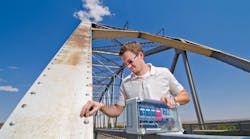In 2016, more than 54,000 bridges in the U.S. were classified “structurally deficient” by the Federal Highway Administration’s National Bridge Inventory. That means about 9% of U.S. bridges need to be regularly monitored. “Areas that are difficult to access or things that are remotely located such as bridges, pipelines, and other critical structures present significant challenges to properly monitoring the health of the structure or equipment,” says Dennis Roach, a senior scientist at Sandia National Labs. “A network of structural health monitoring sensors could be a solution, or at least help ensure the necessary vigilance over these components.”
Recently, Sandia and Structural Monitoring Systems, which has a significant presence in North America, worked together with Delta Air Lines Inc. and the Federal Aviation Administration to get the comparative vacuum monitoring sensors industry-certified for crack detection on commercial aircraft. Roach’s work with structural health monitoring for commercial aircraft began in 2001 through the FAA’s Airworthiness Assurance Center, which has been operated by Sandia for the FAA since 1990. He eventually came to suspect that the same sensors could be used on bridges.
In a field test of structural health monitoring, eight comparative vacuum sensors were installed on a bridge. Each consists of a vacuum pump that forms a vacuum; a controller to turn on the vacuum pump and periodically check the sensors; and a wireless transmitter to autonomously call or text maintenance engineers if a crack is detected. The network is powered by a lithium-ion battery, which is recharged by a solar panel.
The sensors were placed along several welds on a truss 100 ft above the deck, or flat road surface, on a suspension bridge.
The sensors produced by Structural Monitoring Systems are made of thin, flexible Teflon and have rows of little channels called galleries. They can be stuck onto critical joints or welds or mounted near other places cracks are likely to form. When the metal is whole, the pump can remove all the air from the galleries, forming a vacuum. When a tiny crack forms in the metal underneath the sensor, a gallery can no longer form a vacuum and the sensors detect this. The sensors can detect cracks smaller than the thickness of a dime.
The sensors can be produced in many different shapes, depending on the region that needs to be monitored, such as across a long weld or around a series of bolts. A series of them can even be placed in front of a tiny crack to see whether it grows and, if so, how fast. Each sensor has several control galleries and sets of monitoring hardware so it can tell if something’s wrong with the sensor or connecting tubes. Because of these control galleries, the sensors are practically foolproof.
Henry Kroker, a Structural Monitoring engineer who played a key role in the bridge monitoring project, says, “Comparative vacuum monitoring sensors provide an elegant ‘Green-Light, Red-Light’ method for constantly surveying critical components. In many years of trial and permanent use in the aviation and now civil industries, these sensors have not produced any false calls.”
Roach and his team also use piezoelectric sensors, fiber optics, and printed eddy current sensors for structural health monitoring. Printed eddy current sensors, a Sandia-patented technology, can be installed on curved surfaces and uses changes in a magnetic field to detect cracks. On the other hand, a network of piezoelectric sensors can monitor a wide area instead of just a few patches. Each sensor takes turns sending out vibrations through the underlying material that the other sensors receive. Cracks or other damage within the sensor network change the “pitch” of these vibrations. However, these pitch changes are more complex than the “yes” or “no” results from the vacuum monitors. While comparative vacuum monitoring is ready and certified for commercial use, the other technologies are still in various stages of lab and field testing.
Structural health monitoring is especially good for hard-to-reach or remote areas, but Roach admits that it’s not a panacea for all inspection needs. “There’s still plenty of times when you want a human in there with a flashlight or other inspection equipment, reasoning it out,” he says, but adds, “Structural health monitoring is only beginning to scratch the surface of the varied types of infrastructure it could be used for.”
Railcars and rail lines, ships, wind turbines, power plants, remote pipelines, storage tanks, vehicles, and even buildings could benefit from real-time, remote structural health monitoring. “The civil infrastructure industry is becoming more aware of the benefits structural health monitoring can provide and is now interested in using them,” says Roach.

